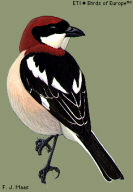 Monitoring
of Austrian Breeding Birds
Monitoring
of Austrian Breeding Birds Monitoring
of Austrian Breeding Birds
Monitoring
of Austrian Breeding Birds
Woodchat Shrike (Lanius senator)
Source: CD-ROM Birds of Europe 1.0 from
ETI
Please do not plagiarize. If you would
like to use this information in a print or electronic publication,
please ask me for
permission first and cite this page as:
Knapp, Robbin D. 2008.
"Monitoring of
Austrian Breeding Birds". In Robb: Biology. Jun. 22,
2008.
In central Europe and therefore also in Austria the population of many bird species has greatly decreased in the past decades; some species which were once widely distributed have either disappeared as breeding birds in the last 20 years in Austria (e.g. Woodchat Shrike Lanius senator), or they have been reduced to hardly survivable relict populations (e.g. Common Barn Owl Tyto alba, Blue Roller Coracias garrulus, Lesser Gray Shrike Lanius minor und Ortolan Bunting Emberiza hortulana).
These negative developments of especially sensitive species clearly reflects the continuously deteriorating environmental situation of our cultivated landscape. Less known, however, is that partly even bird species that are yet omnipresent and considered by many to be common have drastically decreased in population, as several investigations in the past years have shown. In England for example the Eurasian Tree Sparrow Passer montanus has fallen off up to 90 % in some areas in the last 20 years. Much the same can be said for the Eurasian Skylark Alauda arvensis and Song Thrush Turdus philomelos. The numbers of many species of open cultivated areas has greatly decreased (e.g. Corncrake Crex crex, Gray Partridge Perdix perdix and Eurasian Skylark), as have those of formerly widespread garden species like the Eurasian Wryneck Jynx torquilla and Redstart Phoenicurus phoenicurus; large population losses have even been determined for species such as the Eurasian Tree Sparrow and House Sparrow Passer domesticus in some regions.
On the other hand some less demanding species are becoming more common and spreading out. These developments are also reactions to changing environmental conditions and accordingly should not be ignored.
What has been lacking in Austria till now was representative information based on data which could be duplicated, including information on common bird species. Such programs have been running successfully in other European countries for almost 30 years now in some cases and are a cornerstone of the bird conservation activities of these countries.
Bird monitoring is long-term, standardized collection of data on bird populations. Above all changes in the size of the population in different habitats and the distribution of the birds are investigated. The data gathered in this way are indispensible as the basis for recognizing changes in populations, for bird and wildlife conservation and for ecological research. BirdLife Austria stores the results in a database and will publish reports on the situation of the domestic bird fauna at regular intervals (about every 3 years). On a longer-term basis these data will represent an indispensible basis for the assessment of running developments and beyond that will also influence future approaches to wildlife conservation, agriculture and landscape planning.
Text by Michael Dvorak, translated by Robbin D. Knapp.
The monitoring of breeding birds in Austria began with the 1998 breeding season. The method used is point stop count, a simplified form of the so-called point count method. Twice a year the same stretches are counted for as many years in a row as possible.
I count birds on a forest stretch in the province of Upper Austria.
Related Links & Literature![]()


Robb's Homepage | Biology | Feedback
Copyright © 1998-2008 Robbin D. Knapp robb@robbsbooks.com.